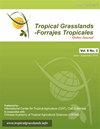饲喂乌罗克洛亚杂交品种“眼镜蛇”对坦桑尼亚牛奶生产的效益
IF 0.7
4区 农林科学
Q3 AGRICULTURE, DAIRY & ANIMAL SCIENCE
引用次数: 0
摘要
动物遗传、管理、疾病、饲料和环境影响牛的产奶量。饲料是最重要的,当解决问题时,牛会立即做出反应。在撒哈拉以南非洲,牲畜生产力较低,主要是由于使用劣质作物残茬和天然牧场,往往缺乏牲畜生产性能所需的关键营养素。在为期8周的有农民参与的农场饲养试验中,比较了农民实践(FP)下的产奶量与使用改良的Urochloa杂交品种“Cobra”干草(Cobra干草)作为干预(In)的产奶量。采用交叉设计,每头奶牛分别经历FP和IN阶段。前2周,实验采用FP,第3周改为50-50 FP/IN,第4周和第5周改为100% IN,第6周改为50-50 FP/IN,第7周和第8周改为100% FP。全氮处理下产奶量提高了15%,并且每升2千克DM眼镜蛇干草的饲料利用效率更高。在坦桑尼亚和撒哈拉以南非洲其他类似的热带生态和环境中,使用眼镜蛇干草有可能提高乳制品产量。本文章由计算机程序翻译,如有差异,请以英文原文为准。
Benefit of feeding Urochloa hybrid cultivar ‘Cobra’ on milk production in Tanzania
Animal genetics, management, diseases, feeds and environment affect milk production in cattle. Feed is the most important and when addressed, cattle show immediate responses. In sub-Saharan Africa, livestock productivity is low largely due to use of low-quality crop residues and natural pastures, often poor in key nutrients for animal performance. In an 8-week on-farm feeding trial with farmers’ participation, milk production under farmers’ practice (FP) was compared with the use of improved Urochloa hybrid cultivar ‘Cobra’ hay (Cobra hay) as an intervention (IN). A crossover design with each cow undergoing FP and IN phases was used. For the initial 2 weeks, the experiment followed FP before shifting to 50-50 FP/IN in week 3 and 100% IN in week 4 and 5, followed by 50-50 FP/IN in week six and 100% FP in week 7 and 8. Milk production increased by 15 % under IN and was associated with better feed utilization efficiency of 2 kg DM Cobra hay/L of milk. The use of Cobra hay has potential to increase dairy productivity in Tanzania and other similar tropical ecologies and contexts in sub-Saharan Africa.
求助全文
通过发布文献求助,成功后即可免费获取论文全文。
去求助
来源期刊

Tropical Grasslands-Forrajes Tropicales
Agricultural and Biological Sciences-Agronomy and Crop Science
CiteScore
1.60
自引率
0.00%
发文量
36
审稿时长
16 weeks
期刊介绍:
The Journal publishes, in English or Spanish, Research Papers and Short Communications on research and development, as well as contributions from practitioners (Farmer Contributions) and Review Articles, related to pastures and forages in the tropics and subtropics. There is no regional focus; the information published should be of interest to a wide readership, encomprising researchers, academics, students, technicians, development workers and farmers.
In general, the focus of the Journal is more on sown (''improved'') pastures and forages than on rangeland-specific aspects of natural grasslands, but exceptions are possible (e.g. when a submission is relevant for a particularly broad readership in the pasture and forage science community).
The Journal will also consider the occasional publication of associated, but closely related, research in the form of an additional scientific communication platform [e.g. a re-make of the former Genetic Resources Communication series of the former Division of Tropical Crops and Pastures of the Commonwealth Scientific and Industrial Research Organisation (CSIRO), Australia].
Areas of particular interest to the Journal are:
Forage Genetic Resources and Livestock Production[...]
Environmental Functions of Forages[...]
Socio-economic Aspects[...]
Topics within the aforementioned areas may include: Diversity evaluation; Agronomy; Establishment (including fertilization); Management and utilization; Animal production; Nutritive value; Biotic stresses (pests and diseases, weeds); Abiotic stresses (soil fertility, water, temperature); Genetics and breeding; Biogeography and germplasm collections; Seed production; Ecology; Physiology; Rhizobiology (including BNF, BNI, mycorrhizae); Forage conservation; Economics; Multilocational experimentation; Modelling.
 求助内容:
求助内容: 应助结果提醒方式:
应助结果提醒方式:


